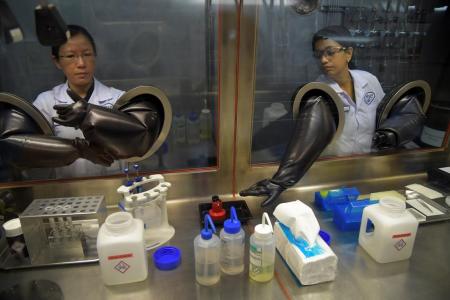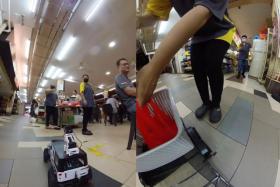DSO laboratory keeps Singapore safe
An unattended package in Shenton Way is discovered and found to be radioactive. Police have set up a safety cordon, disrupting activity in the Central Business District.
In such a scenario, scientists at defence research organisation DSO National Laboratories can be called upon to identify the substances, and they have developed processes to cut the time needed to do so.
For instance, identifying the exact nature of nuclear material plutonium now takes just six hours, less than 10 per cent of the original three days required.
For radioactive substances like thorium, the time taken to nail down an identity has been reduced from six hours to one.
"We recognised that five to six hours is not acceptable, as our ground responders are out there waiting for an answer on what the substance is," said Dr Pong Boon Kin, 44, head of the nuclear forensics laboratory.
These processes for the testing of radiological and nuclear samples are being developed at DSO, which also conducts the testing and verification of chemical and biological samples at its high-containment facility.
It is one of 16 similar facilities worldwide certified by the United Nations' Organisation for the Prohibition of Chemical Weapons, and the only one in South-east Asia.
The facility was among several projects showcased by DSO, in a rare media tour last Thursday.
Set up in 1972 as the Electronics Test Centre and renamed in 1977 as the Defence Science Organisation, DSO was corporatised and acquired its current name in 1997.
While its primary goal is to support national defence as the technology partner of the Singapore Armed Forces, the 45-year-old organisation also develops technologies that protect national security.
Its largely invisible work takes place at the DSO Complex in Science Park Drive, which officially opened in April and features a floor area of 69,000 sq m across two eight-storey buildings. It has more than 1,800 employees and spends more than $250 million in research every year.
Another pioneering project is a BIOS verifier, which is able to detect malware that is stealthy enough to reside in a computer's BIOS, or the firmware that boots up when a computer is turned on.
Malware planted in a computer's BIOS allows the attacker to take control, accessing files and recording the victim using the computer's webcam, for instance.
Commercially available anti-virus software is typically installed in a computer to protect applications and the operating system from malware infections, but it is unable to detect those hiding in places such as the BIOS, said Mr Yap Chun Beng, 45, the principal research engineer at the information division.
Get The New Paper on your phone with the free TNP app. Download from the Apple App Store or Google Play Store now



